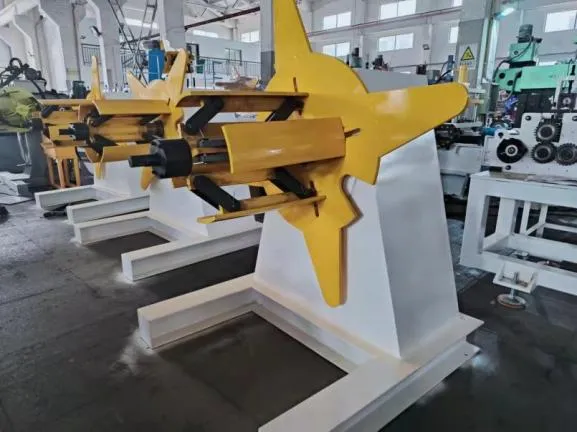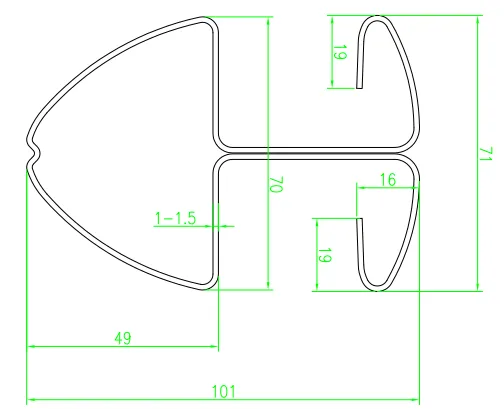High-Efficiency Standing Seam Metal Roof Roll Former – Portable & For Sale
- Introduction to standing seam metal roof roll former
and its industry significance - Technical advantages of advanced roll forming technology
- Comparison of leading manufacturers and their product offerings
- Customizable solutions and factors influencing purchase decisions
- Real-world application cases and success stories
- Return on investment, maintenance, and long-term value
- Summary and future trends of standing seam metal roof roll former

(standing seam metal roof roll former)
Exploring the Standing Seam Metal Roof Roll Former Market
The standing seam metal roof roll former is a cornerstone innovation within modern construction, especially for commercial and industrial roofing solutions. With the ongoing surge in demand for durable, energy-efficient, and sustainable materials, the utilization of advanced roll forming machinery has become essential. Industry reports indicate that the global metal roofing market size reached approximately $18.7 billion in 2022 and is projected to rise at a CAGR of 4.3% through 2028 (Source: MarketsandMarkets). This growth is fueled largely by the versatility and reliability provided by machines like the standing seam roll former for sale today. Contractors and fabricators seek portable standing seam roll former units to achieve faster on-site installation and to manage complex architectural designs. This article delves into the technologies, offers manufacturer comparisons, and showcases industry case studies that illustrate the pivotal role of these machines.
Technical Advantages: Precision, Efficiency, and Innovation
Engineering advancements have redefined what a standing seam roll former can accomplish. Precision is now measured in tolerances as tight as ±0.5 mm, which ensures seamless panel interlocks for exceptional weather resistance and aesthetic consistency. Leading models now offer high-speed production capabilities—some enable throughput up to 45 meters per minute—and feature servo-driven feeds, automatic length adjustment, and twin decoilers for rapid material changes. Portable standing seam roll formers especially have risen in popularity due to their compact design and ease of transportation, weighing as little as 950 kg compared to traditional stationary units exceeding 2,000 kg. Additionally, automation has brought about digital panel profiling, in-line punching, notching, and integrating coil feed quality control, which drastically reduces waste rates, sometimes by over 12% annually. The post-pandemic construction landscape demands such technical sophistication, notably as labor shortages and delivery deadlines shape buying decisions.
Manufacturer Comparison: Features and Performance Benchmarks
Choosing the right standing seam metal roof roll former involves comparing reputable manufacturers and understanding the product differentiators. The table below highlights five leading suppliers, focused on output speed, portability, material compatibility, and customizable functions:
| Manufacturer | Model | Output Speed (m/min) | Weight (kg) | Max. Panel Width (mm) | Material Thickness (mm) | Automation Features |
|---|---|---|---|---|---|---|
| Bradbury Group | SSRF Pro | 40 | 1,650 | 610 | 0.5-1.2 | Servo-feeder, digital pre-set, decoiler |
| NewTech Machinery | SSQ II | 27 | 925 | 508 | 0.46-0.79 | Touchscreen, notching, multi-profiles |
| Schlebach | Quadro Plus | 12 | 1,020 | 600 | 0.4-1.0 | Expandable profiles, mobile frame |
| Zhongyuan | ZY-SS24 | 33 | 1,320 | 600 | 0.45-1.0 | PLC control, in-line notching |
| Hangzhou Roll Forming | HZRFM-700 | 38 | 1,180 | 700 | 0.5-1.2 | Auto-cutting, remote diagnostics |
When evaluating these machines, buyers often prioritize a balance of panel profile options, speed, and ease of maintenance. Manufacturers have responded with modular designs, plug-and-play upgrades, and support for wider coil dimensions, emphasizing both productivity and uptime.
Custom Solutions: Tailoring Roll Formers for Unique Applications
One critical benefit of modern standing seam roll former units is their adaptability to custom project requirements. Solutions tailored for architectural, commercial, or residential roofing differ in panel shape, seam height, and clip system compatibility. For example, projects in hurricane-prone zones demand raised seam heights and reinforcement for wind uplift, while industrial facilities typically require rapid coil changes and automated stacking to minimize downtime. Engineering teams collaborate directly with clients to specify modular frames, custom rollers, and integrated controls that interface with enterprise building management systems. In addition, several leading suppliers offer mobile field service units, ensuring that customizations are correctly executed, calibrated, and supported post-delivery. Buyers are also demanding IoT-ready platforms to monitor productivity and schedule predictive maintenance, maximizing investment returns while reducing operator error rates by up to 25%.
Application Cases: Success across Diverse Roofing Projects
The deployment of portable standing seam roll former models has produced notable improvements in speed, safety, and quality across a variety of roofing projects. For example, a logistics center in Germany, constructed in 2021, utilized three mid-sized roll formers to produce and install 60,000 square meters of standing seam panels in less than six weeks—a significant enhancement compared to the projected nine-week timeline using prefabricated panels. In the United States, a school district in Texas opted for mobile roll forming on-site, allowing for precise panel fitting and eliminating logistical delays. Maintenance data from these case studies show an up to 18% reduction in leaks and seam separation defects, credited to in-field customization and immediate quality checks. The ability to quickly adapt to geometric complexities of unique rooftops not only extends material service life but also enables green roofing solutions by integrating solar panel mounting brackets and thermal insulation.
ROI, Maintenance Strategies, and Long-Term Value
Investing in a standing seam metal roof roll former can deliver substantial financial returns. Industry averages point to a payback period of 2.4 years for contractors who operate these machines on at least five mid-sized projects annually, thanks to reductions in labor, waste, and transportation costs. Regular preventive maintenance, including weekly lubrications, monthly alignment checks, and software updates, is essential for achieving peak performance. Manufacturers now offer digital maintenance logs and remote diagnostic support which have been proven to reduce unplanned downtime by up to 35%. For end-users, the total cost of ownership is lowered not just by efficient operation but also by the higher-quality panel products these machines generate, leading to fewer warranty claims and callbacks. When built into a vertically integrated workflow, roll forming technology can create recurring revenue streams through retooling for new panel profiles and colors as architectural design trends evolve.
Summary and Future Trends for Standing Seam Metal Roof Roll Former
The standing seam metal roof roll former continues to drive innovation, flexibility, and quality in the metal roofing industry. As the market matures, greater adoption of automation, digital control, and sustainability features is anticipated. Manufacturers are focusing on plug-and-play hardware upgrades and cloud-based monitoring to provide real-time production analytics, with expectations that over 70% of new units shipped by 2026 will be IoT-enabled. Continued emphasis on energy efficiency, recyclable materials, and modular roofing components will cement the role of standing seam roll forming equipment in meeting tomorrow’s construction challenges. Those investing in portable and highly customizable roll formers today are securing competitive advantages not just in the present project cycle, but well into the next era of smart construction.

(standing seam metal roof roll former)
FAQS on standing seam metal roof roll former
Q: What is a standing seam metal roof roll former?
A: A standing seam metal roof roll former is a machine that shapes metal coils into standing seam roofing panels. It forms precise, interlocking seams for strong, weather-resistant roofs. This equipment is essential for efficient fabrication of metal roofing systems.
Q: Where can I find a standing seam roll former for sale?
A: You can find standing seam roll formers for sale from specialized roofing equipment suppliers and manufacturers. Many offer both new and used machines. Online marketplaces and industry trade shows are also good places to explore options.
Q: What are the benefits of a portable standing seam roll former?
A: A portable standing seam roll former allows you to fabricate panels directly at the installation site. This reduces transportation costs and potential panel damage. It also enables customization and quick project turnaround.
Q: How do I choose the right standing seam roll former?
A: Consider your required panel profile, production speed, machine portability, and budget. Look for reputable brands with good support and spare parts availability. It's also wise to request demonstrations or customer references before purchasing.
Q: Can a standing seam metal roof roll former handle different materials?
A: Yes, most standing seam roll formers can process various metals such as steel, aluminum, and copper. Ensure the machine specifications match your material thickness and type. Always verify with the manufacturer for compatibility before use.
